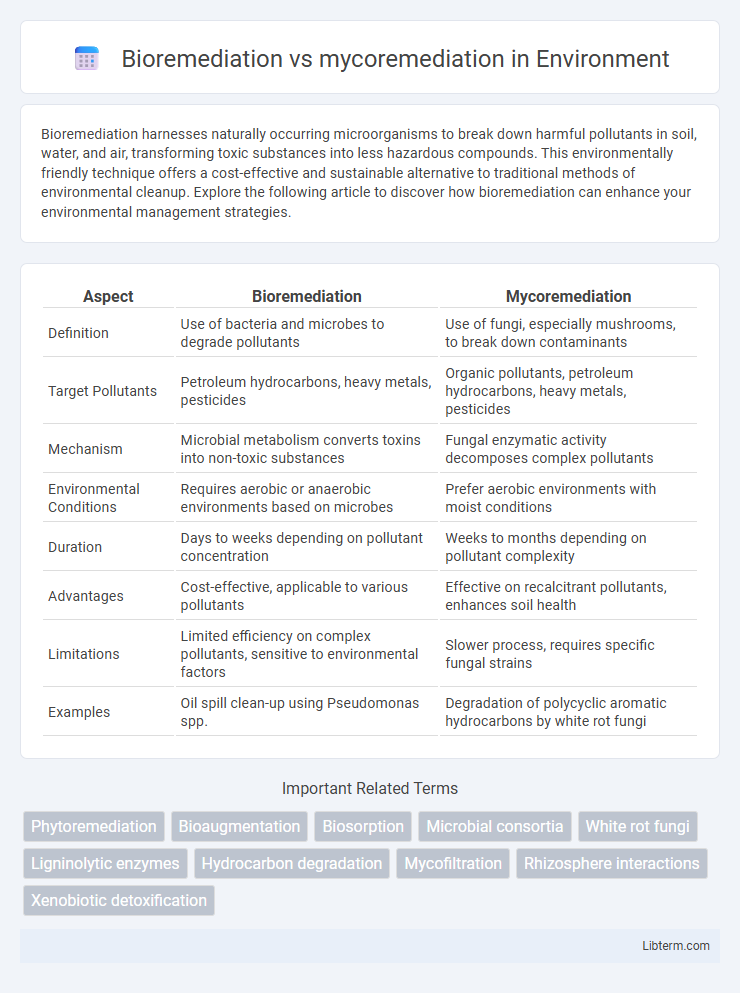Bioremediation harnesses naturally occurring microorganisms to break down harmful pollutants in soil, water, and air, transforming toxic substances into less hazardous compounds. This environmentally friendly technique offers a cost-effective and sustainable alternative to traditional methods of environmental cleanup. Explore the following article to discover how bioremediation can enhance your environmental management strategies.
Table of Comparison
| Aspect | Bioremediation | Mycoremediation |
|---|---|---|
| Definition | Use of bacteria and microbes to degrade pollutants | Use of fungi, especially mushrooms, to break down contaminants |
| Target Pollutants | Petroleum hydrocarbons, heavy metals, pesticides | Organic pollutants, petroleum hydrocarbons, heavy metals, pesticides |
| Mechanism | Microbial metabolism converts toxins into non-toxic substances | Fungal enzymatic activity decomposes complex pollutants |
| Environmental Conditions | Requires aerobic or anaerobic environments based on microbes | Prefer aerobic environments with moist conditions |
| Duration | Days to weeks depending on pollutant concentration | Weeks to months depending on pollutant complexity |
| Advantages | Cost-effective, applicable to various pollutants | Effective on recalcitrant pollutants, enhances soil health |
| Limitations | Limited efficiency on complex pollutants, sensitive to environmental factors | Slower process, requires specific fungal strains |
| Examples | Oil spill clean-up using Pseudomonas spp. | Degradation of polycyclic aromatic hydrocarbons by white rot fungi |
Introduction to Bioremediation and Mycoremediation
Bioremediation utilizes microorganisms such as bacteria and algae to degrade environmental contaminants, transforming pollutants into less harmful substances. Mycoremediation, a subset of bioremediation, specifically employs fungi to break down complex organic pollutants like hydrocarbons and pesticides through enzymatic processes. Both methods offer eco-friendly and cost-effective solutions for soil and water decontamination by leveraging natural biological activity.
Definitions and Core Principles
Bioremediation involves using microorganisms such as bacteria and algae to break down or neutralize contaminants into less harmful substances, relying on metabolic processes to degrade pollutants. Mycoremediation specifically utilizes fungi, exploiting their enzymatic systems and extensive mycelial networks to absorb, transform, or immobilize hazardous compounds in soil and water. Both methods harness natural biological activity to restore environmental health but differ in the type of organisms employed and mechanisms of contaminant breakdown.
Types of Contaminants Addressed
Bioremediation effectively targets a broad range of contaminants including hydrocarbons, heavy metals, pesticides, and industrial solvents by utilizing bacteria and archaea to detoxify polluted environments. Mycoremediation, leveraging fungi, excels in breaking down complex organic pollutants such as polycyclic aromatic hydrocarbons (PAHs), chlorinated compounds, and persistent pesticides through enzymatic processes. Both approaches offer sustainable solutions for soil and water remediation, but mycoremediation shows particular strength in degrading recalcitrant organic contaminants that resist bacterial degradation.
Key Biological Agents Involved
Bioremediation primarily utilizes bacteria such as Pseudomonas and Rhodococcus species, which break down organic contaminants through metabolic processes. Mycoremediation harnesses fungi like white-rot fungi (Phanerochaete chrysosporium) and oyster mushrooms (Pleurotus ostreatus), known for their enzymatic ability to degrade complex pollutants including hydrocarbons and heavy metals. Both approaches exploit natural organisms but differ in the biological agents and mechanisms employed for environmental detoxification.
Mechanisms of Action: Bacteria vs. Fungi
Bioremediation utilizes bacteria to break down contaminants through metabolic processes involving enzymes that degrade pollutants into less harmful substances, primarily via aerobic and anaerobic respiration. Mycoremediation leverages fungi's extensive hyphal networks and enzymatic arsenal, including ligninolytic enzymes, to decompose complex organic pollutants such as hydrocarbons and heavy metals. Bacterial mechanisms often target specific compounds with rapid biodegradation, while fungal processes excel in transforming recalcitrant pollutants through extracellular oxidation and biosorption.
Efficiency and Effectiveness Comparison
Bioremediation uses bacteria and other microorganisms to degrade contaminants, offering high efficiency in breaking down petroleum hydrocarbons and heavy metals in soil and water. Mycoremediation, leveraging fungi's enzymatic capabilities, excels in decomposing complex pollutants like polycyclic aromatic hydrocarbons (PAHs) and persistent organic pollutants (POPs), often achieving faster degradation in challenging environments. Studies demonstrate mycoremediation's superior effectiveness in detoxifying recalcitrant compounds, while bioremediation provides broader applicability and scalability across diverse contamination scenarios.
Environmental Impact and Sustainability
Bioremediation utilizes bacteria and microorganisms to degrade pollutants, offering efficient detoxification of soils and water with minimal ecological disruption. Mycoremediation leverages fungi's enzymatic capacity to break down complex contaminants, often achieving deeper penetration and persistence in treatment of heavy metals and hydrocarbons. Both approaches promote sustainability by enhancing natural degradation processes and reducing reliance on chemical remediation, with mycoremediation often providing greater biodiversity benefits and soil health restoration.
Practical Applications and Case Studies
Bioremediation employs bacteria to degrade pollutants in contaminated soils and water, proven effective in petroleum hydrocarbon spill cleanup, as seen in Exxon Valdez oil spill recovery efforts. Mycoremediation uses fungi, particularly white-rot fungi species like Phanerochaete chrysosporium, to break down complex organic contaminants including pesticides and heavy metals, demonstrated in studies remediating polycyclic aromatic hydrocarbons (PAHs) in industrial sites. Both methods show promise in practical environmental restoration with bioremediation favored for faster degradation rates and mycoremediation for its ability to target recalcitrant compounds.
Limitations and Challenges
Bioremediation faces limitations such as dependency on specific environmental conditions like pH, temperature, and nutrient availability, which can hinder microbial activity and pollutant degradation efficiency. Mycoremediation encounters challenges including the slow growth rates of fungi and difficulty in maintaining optimal moisture and aeration levels for fungal enzyme production. Both methods struggle with incomplete degradation of complex contaminants and potential accumulation of toxic byproducts, requiring careful monitoring and site-specific customization.
Future Perspectives and Innovations
Future perspectives in bioremediation emphasize the integration of genetic engineering and nanotechnology to enhance microbial degradation of pollutants, improving efficiency and specificity in contaminated site cleanup. Innovations in mycoremediation involve the use of genetically modified fungi with enhanced enzymatic pathways for breaking down complex organic toxins and heavy metals, offering sustainable and cost-effective remediation options. Combining advances in omics technologies and AI-driven modeling accelerates the development of tailored microbial and fungal consortia, optimizing environmental restoration efforts and expanding applicability across diverse ecosystems.
Bioremediation Infographic

 libterm.com
libterm.com